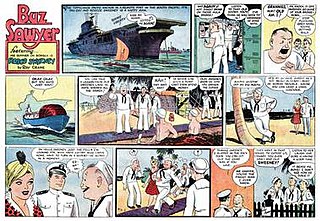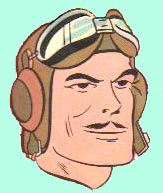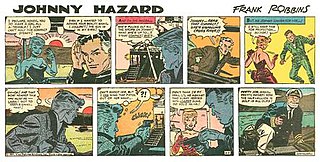Marvin, later called Marvin & Family, is a daily newspaper comic strip created by cartoonist Tom Armstrong and distributed in the U.S. by Hearst's King Features Syndicate. Debuting in 1982, it revolves around the life and times of a young baby boy named Marvin, along with his parents, Jeff and Jenny Miller, and their dog Bitsy. In 1989, CBS aired a special, "Marvin, Baby of the Year."

King Features Syndicate, Inc. is an American content distribution and animation studio, consumer product licensing and print syndication company owned by Hearst Communications that distributes about 150 comic strips, newspaper columns, editorial cartoons, puzzles, and games to nearly 5,000 newspapers worldwide. King Features Syndicate also produces intellectual properties, develops new content and franchises, like The Cuphead Show!, which it produced with Netflix, and licenses its classic characters and properties. King Features Syndicate is a unit of Hearst Holdings, Inc., which combines the Hearst Corporation's cable-network partnerships, television programming and distribution activities, and syndication companies. King Features' affiliate syndicates are North America Syndicate and Cowles Syndicate.

Henry is a comic strip created in 1932 by Carl Thomas Anderson. The title character is a young bald boy who is mute. Except a few early episodes, the comic strip character communicates largely but not entirely through pantomime, a situation which changed when Henry moved into comic books. Henry has spoken in at least one Betty Boop cartoon from 1935. In the feature, Betty Boop has a pet shop and Henry speaks to a dog in the window.

William Morgan DeBeck, better known as Billy DeBeck, was an American cartoonist. He is most famous as the creator of the comic strip Barney Google, later retitled Barney Google and Snuffy Smith. The strip was especially popular in the 1920s and 1930s, and featured a number of well-known characters, including the title character, Bunky, Snuffy Smith, and Spark Plug the race horse. Spark Plug was a merchandising phenomenon, and has been called the Snoopy of the 1920s.
Frank Miller was an American cartoonist.

Buz Sawyer is a comic strip created by Roy Crane. Distributed by King Features Syndicate, it had a run from November 1, 1943 to October 7, 1989. The last strip signed by Crane was dated 21 April 1979.

William Lemuel "Willie" Lumpkin is a fictional supporting character appearing in American comic books published by Marvel Comics. The character is best known as the mailman of the Fantastic Four in their self-titled comic book.
United Feature Syndicate, Inc. (UFS) is a large American editorial column and comic strip newspaper syndication service based in the United States and established in 1919. Originally part of E. W. Scripps Company, it was part of United Media from 1978 to 2011, and is now a division of Andrews McMeel Syndication. United Features has syndicated many notable comic strips, including Peanuts, Garfield, Li'l Abner, Dilbert, Nancy, and Marmaduke.

The Adventures of Smilin' Jack is an aviation comic strip that first appeared October 1, 1933, in the Chicago Tribune and ended April 1, 1973.

Radio Patrol is a police comic strip carried in newspapers from August 7, 1933 to December 16, 1950 in the dailies, with a Sunday strip that ran from November 25, 1934 to October 20, 1946. It was created by artist Charles Schmidt and writer Eddie Sullivan, who both worked for the Boston American. Sullivan was a newspaper reporter who specialized in crime reporting.

August Daniel Carter (1895–1957) was an American comic strip cartoonist who created the long-running Just Kids strip. He was known as Ad Carter, the signature he used on his strips.

Little Jimmy, originally titled Jimmy, is a newspaper comic strip created by Jimmy Swinnerton. With a publication history from February 14, 1904, to April 27, 1958, it was one of the first continuing features and one of the longest running.
This is a timeline of significant events in comics in the 1910s.

Crack Comics was an anthology comic book series published by Quality Comics during the Golden Age of Comic Books. It featured such characters as The Clock, Black Condor, Captain Triumph, Alias the Spider, Madame Fatal, Jane Arden, Molly the Model, and Red Torpedo. The title "crack" referred to "being at the top of one's form", like a "crack sharpshooter".
Harry Frank Sahle was an American comic book artist who drew for such publishers as Archie Comics—helping create the defined look of Archie Comics' breakout character, Archie Andrews—Quality Comics and the Marvel Comics precursor company Timely Comics during the 1930s-1940s period historians and fans call the Golden Age of Comic Books.

Johnny Hazard is an action-adventure comic strip created by cartoonist Frank Robbins for King Features Syndicate. It was published from June 5, 1944, until August 20, 1977, with separate storylines for the daily strip and the Sunday strip.

Right Around Home was a comic strip by Dudley Fisher that was distributed by King Features Syndicate from January 16, 1938 to May 2, 1965.

Half Hitch is an American comic strip by Hank Ketcham, in syndication first between 1943 and 1945 and later from 1970 to 1975. It is an example of military humor, but unlike most cartoons and comics of this genre, is focused on the navy, rather than the army. The unnamed character first appeared in The Saturday Evening Post in 1943.

Sol Hess was a comic strip writer best known for creating the long-run strip The Nebbs with animation artist Wallace Carlson.
The Register and Tribune Syndicate was a syndication service based in Des Moines, Iowa, that operated from 1922 to 1986, when it was acquired by King Features to become the Cowles Syndicate affiliate. At its peak, the Register and Tribune Syndicate offered newspapers some 60 to 75 features, including editorial cartoonist Herblock, comic strips, and commentaries by David Horowitz, Stanley Karnow, and others.















